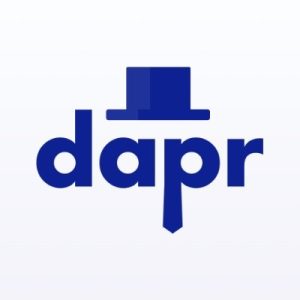Dapr dresses up for CNCF project graduation + Diagrid delights
Dapr, or Distributed Application Runtime, is a portable runtime that makes it easy for any developer to build distributed applications that run across cloud and edge computing environments.
Increasing in popularity and spread (at the time of writing), Dapr provides a set of integrated application programming interfaces (APIs) for building secure distributed applications.
The Cloud Native Computing Foundation (CNCF) used KubeCon + CloudNativeCon North America this month to detail the project’s graduation.
The CNCF is upbeat about the project and explains that it provides integrated APIs for communication, state and workflow for building production-ready applications. It uses best practices for security, resiliency and observability, which is where the developer productivity figure comes from.
“Dapr has a single mission: to meet the emerging needs of developers and solve the most complex problems in distributed computing,” said Yaron Schneider, Dapr maintainer and steering committee member and CTO, co-founder of Diagrid. “The project has done very well in helping application developers navigate the complexities of cloud-native architectures, and the engagement with the CNCF community proved to be an amazing catalyst for the project’s growth and maturity”
The Dapr project was first released in 2019 at Microsoft and was accepted into the CNCF Incubator in November 2021. Since then, Dapr has grown to over 3,700 individual contributors from more than 400 organisations.
Workflows, secrets, cryptography & configs
Today, Dapr is maintained by 21 individuals affiliated with eight organisations who have released regular versions every quarter with new developer APIs, including workflows, secrets, cryptography, configuration management and LLMs. Together, the Dapr SDKs have over 70 million downloads, with 50 million image pulls.
“Dapr’s API approach coupled with its ability to rapidly swap underlying infrastructure, whether that is storage, message brokers or secret stores, has enabled any developer to tackle the complexities of building microservices architectures and deliver business value,” said Mark Fussell, Dapr maintainer and steering committee member, CEO and co-founder of Diagrid. “CNCF has been perfect for Dapr to grow a strong community with other cloud native technologies in a vendor-neutral environment.
In an era where traffic is king, Dapr maintainer and steering committee member Loong Dai has said that Dapr has redefined distributed application development by helping developers focus on business logic.
Integration situation
Dapr integrates with many projects in the cloud native ecosystem, including OpenTelemetry to generate and export telemetry data, Prometheus to collect and analyse runtime metrics, SPIFFE for identifying and securing services, gRPC and Cloud Events for sending communications between application services.
“In today’s competitive environment It’s more important than ever for organisations to be able to ship reliable and scalable applications quickly,” said Chris Aniszczyk, CTO, CNCF. “Dapr provides a comprehensive solution for developing edge and cloud-native applications, saving developers valuable time and freeing them to focus on innovating.”
The Dapr control plane, which, among other capabilities, deploys Dapr sidecars for each application, is hosted on Kubernetes and is deployed with Helm charts.
“We see Dapr leveling the playing field for developers of all skill ranges who can build distributed apps and cloud backends with best practices like mTLS, app security policy, resiliency and thread safety that are built-in. For more sophisticated workloads we are seeing the reliable chaining and orchestration of AI pipelines & multiple models using Workflow,” said Paul Yuknewicz, Dapr steering committee member and group product manager for Azure Serverless at Microsoft.
This technology is capable of decoupling infrastructure concerns from business logic to make systems more resilient and adaptable. Users have said that the seamless service-to-service communication and robust pub/sub features have been game-changers and that with Dapr, it is easier to transition from monolithic applications to distributed environments for developers.
Diagrid details dev delectations
In line with the news from the CNCF comes updates from Diagrid, a provider of enterprise tools and services for building portable applications. The company is a project maintainer for Dapr alongside Microsoft, Intel, Alibaba and others.
 As organisations seek to take advantage of artificial intelligence (AI), Diagrid says they face a critical challenge of how to reliably customise large language models (LLMs) and integrate AI into their applications.
As organisations seek to take advantage of artificial intelligence (AI), Diagrid says they face a critical challenge of how to reliably customise large language models (LLMs) and integrate AI into their applications.
The Dapr 1.15 new conversation Application Programming Interface (API), will enable developers to build AI-enhanced applications powered by customised LLMs. Using the conversation API reduces the complexity of interacting with LLMS and enables critical security and reliability functions with capabilities like prompt caching and PII data obfuscation.
Also, with Dapr 1.15, the Workflow API that was in beta is upgraded to production-ready status. Workflows enable developers to reliably orchestrate microservices – resulting in reliable, long-running, stateful applications.
“Developers are increasingly being tasked with customising generic LLMs. Using Dapr, they can code workflows to reliably orchestrate retrieval augmented generation (RAG) pipelines for LLM customisation, then use the conversation API to query the LLM, with built-in prompt caching” said Mark Fussell, co-creator of Dapr and CEO of Diagrid. “An additional benefit of Dapr is that it protects developers as AI technology evolves so it’s possible to switch one LLM technology for another with zero impact on the application. As enterprises strive to maintain competitiveness, architecting AI into applications so it can evolve is critical.”
Dapr is an open source Cloud Native Computing Foundation graduation project created by Diagrid founders Fussell and Yaron Schneider in 2019. Today Dapr provides developers with APIs that aim to abstract away the complexity of the most common challenges when building distributed applications.
Developer productivity
It increases developer productivity by 20-40% with features such as workflow, pub/sub, state management, secret stores, jobs scheduler, external configuration, bindings, actors, distributed lock and cryptography.
Dapr enables developers to benefit from its built-in security, reliability and observability capabilities, so they don’t need to write boilerplate code to achieve production-ready applications.




